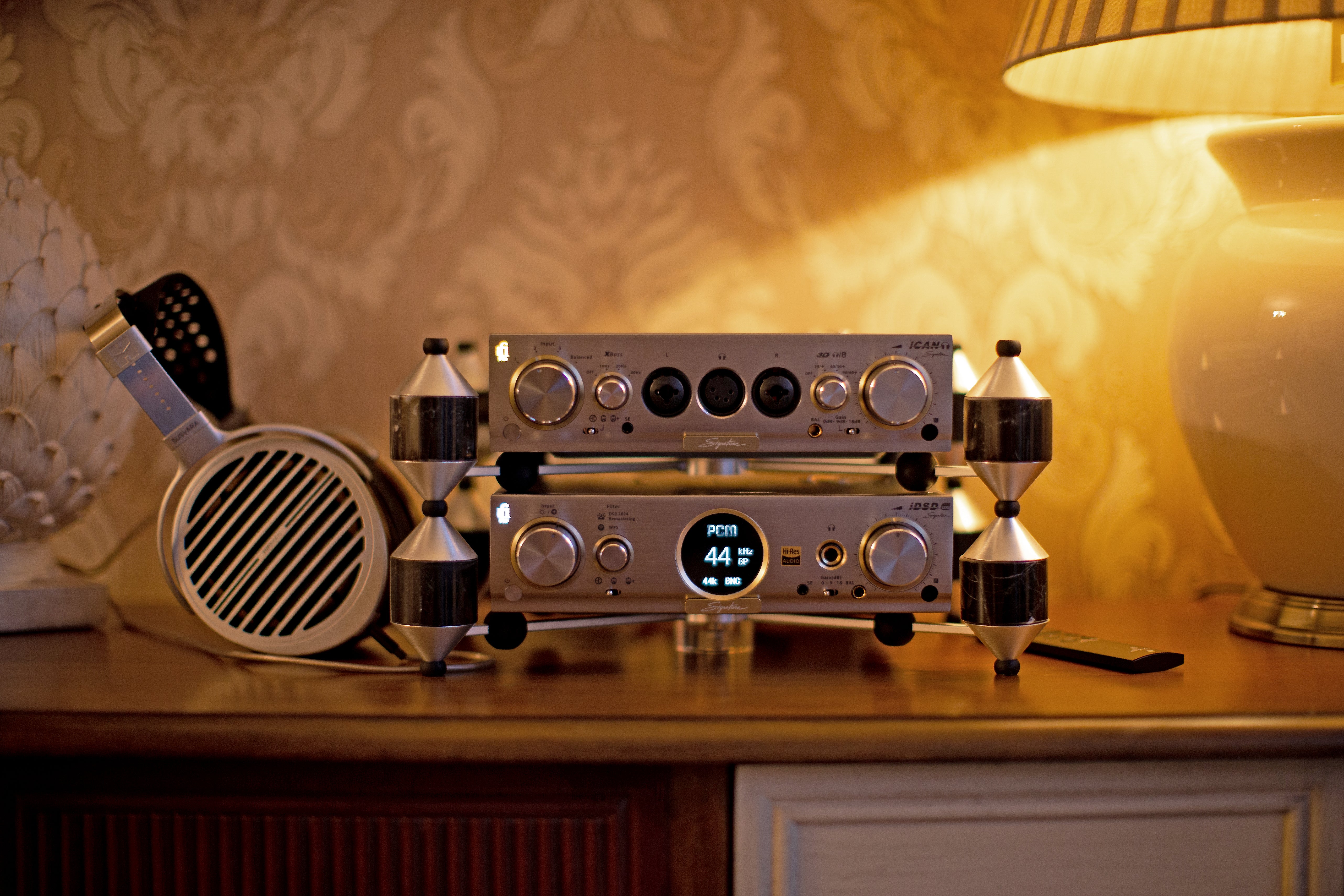While iFi is best known for their lines of portable and budget DACs and amps, like the micro iDSD and ZEN series products, they also know how to take their sound game to the next level with flagship desktop products like the Pro iDSD Signature and Pro iCAN Signature. It’s a big jump from the portable $999 Diablo to a $3249 desktop DAC and $2249 amp, so the question is, can iFi deliver on the flagship sound and performance promised by that price tag?
Build and Design
The Pro iDSD Signature and iCAN signature share many visual and tactile similarities. The core components of the case, as well as the basic components like the volume knob are the same. Both have a silver chassis with gold accents and feature the same style switches and jacks. All of the elements are quite sturdy with a good amount of resistance and a satisfying click to the switches, as well as a secure feeling to the jacks with little to no flex.

Both devices include an upgraded iPower Elite power supply and a remote. Each also includes everything you need to get going and connected with a couple different options. The Pro iDSD includes a USB cable for digital input and a stereo RCA cable for output to another source. You also get the coax to optical adapter from the combo digital input. For the Pro iCAN, you just get the RCA cables.
There’s a good selection of input and output options on both units, with 3.5mm and 6.3mm outputs, as well as 4.4mm balanced. On the Pro iDSD, the 3.5mm connection is S-Balanced to provide balanced level power output without the a true balanced connection, while on the iCAN, you don’t have anything S-Balanced, but you also get the dual style connectors for balanced output with a split 6.3mm or 3-pin XLR connector (this is more common in pro audio applications than for audiophile/hi-fi setups.)
Interface
While only the Pro iDSD Signature has a screen to display information back to the user, both have quite a bit of potential configuration. While they share some similarities – like the gain and tube selection – these are, at their core, different devices with different functions, and different capabilities.
For the tube selection, you have three options: fully solid state, Tube, or Tube+. Tube mode switches from the solid state output to the tube, which provides an increased feeling of warmth and smoothness to the sound. Tube+ mode pushes the tubes even more, creating a stronger feeling of euphonic harmonic distortion. Gain also gives you three options – essentially low, medium, and high – at 0dB, 9dB, and 18dB.
Pro iDSD Signature
The first selection on the Pro iDSD Signature is the Input. You can choose between any of the digital input options, including App which works with services like the DLNA streaming protocol, TIDAL, or Spotify Connect to directly output to the device. The wireless setup was relatively easy, though not totally painless. Regrettably, it doesn’t use the same internal system as the recently released ZEN Stream, so you’ll need to use an external app like the MUZO or WiiM Player to set up the connection.
Next is the Filter option where you can select from the various DAC filters, including Apodizing, Gibbs Transient Optimized, Bit Perfect, Bit Perfect+, and Transient Aligned. Each uses a different algorithm to process the digital file and results in a slightly different character to the output. Pressing in this switch allows you to switch the DSD playback mode, and this one even has a third function as you can hold it in to negotiate a connection with a WPS router.

iFi provides a small tool for adjusting the controls on the back of the unit, which includes whether it’s fixed or variable and whether you’re the recommended Hi-Fi setting for the balanced XLR output (4.6V) or outputting for Pro Audio (11.2V). There’s also an option to adjust the clock sync mode for when the unit is connected to the internet.
Pro iCAN Signature
The Pro iCAN Signature is a little more straightforward to set up. You don’t need to have a clue what “Gibbs Transient Optimized” means, or consider whether or not you want to sync with the Atomic Clock. It’s more just a matter of what you’re plugged into and selecting the correct serving sizes for power and tubes to sculpt your desired sound. Of course, it does have the XBass and 3D Holographic options, but those aren’t quite as technical in their explanation as the differences between DAC filters
XBass is an analog signal processor that provides a fairly generous low range boost, and while it’s a feature included on many iFi devices, only the Pro iCAN provides the option to adjust the size of the boost. Xbass essentially creates a shelf going down into the subbass, and the selector allows you to determine where that shelf starts. There is also some degree of ramp up into the shelf, so setting it at 40Hz will provide a large boost to frequencies at 40Hz and below and a more modest boost up to 160Hz.

The 3D Holographic feature creates a sensation of distance and space with headphones, and also expands the feeling of space with loudspeakers. With headphones, the indicated numbers essentially describe the angle of the theoretical speaker placement, 30 degrees being narrow, 60 being wide, and 90 being somewhat exaggerated. If this feature is used with the line out, it provides a higher degree of spatial correction, and an additive effect to the speaker angle. Essentially, at 30 degrees, rather than simulate the feeling of that speaker angle, it would create the sensation of speakers placed 30 degrees wider than your current speakers are.
Sound
So there’s a lot of very cool tech crammed into these units, and honestly, a lot of power on display, but how do they sound? The core sound is an accurate detailed output that’s slightly on the warm side of neutral. There’s just a touch of bass emphasis and a subtle feeling of smoothness around the upper frequencies. As a whole, the sound of the Pro Signature series is more transparent than iFi’s original Pro lineup, and it presents with a heightened level of sound quality across the board.
The Pro iDSD Signature has a surprising amount of power by itself, with the balanced output and S-Balanced 3.5mm pushing 11.2V, which can comfortably drive a wide variety of headphones.The Pro iCAN, of course, puts out more than that from its single-ended outputs, and pushes a whopping 23V for balanced headphones. That can comfortably drive any conventional headphone on the market to ear splitting levels. This means that with either unit – and especially the iCAN – you can get excellent dynamics, slam, and headroom with your whole collection.

Running the iDSD by itself, the tube mode is largely transparent, but has some effect on the midrange and highs. Regular Tube mode rolls down the treble a bit, taking some of the crispness out of cymbals and softening some of the sparkle. With a headphone with brighter treble, like the HIFIMAN Arya, this can greatly reduce fatigue for more treble sensitive listeners. Tube+ moves things away from transparent and towards a more characteristically warm sound, with a touch of that aforementioned smooth euphonic harmonic distortion.
The DAC filters are more of a subtle tweak to the sound than the tubes. It was very difficult to tell the difference between Bit Perfect and Bit Perfect+, which both seemed highly neutral. The other settings had a bit of progression into a very clean, but almost “oversampled” sounding output, starting from Gibbs Transient through Apodizing and Transient Aligned. Transient Aligned has a touch of that Chord Electronics feeling of incredible detail and lightning fast response.
For the iCAN, the tube selection had the same effect as iDSD’s tubes, and if you have both units plugged together, the tubes are only applied in the final amp stage from the iCAN, so you can’t double up on them. The DAC filters from the iDSD, of course, do apply, so the mixture of DAC filters and tube options, along with the 3D Holographic matrix can give you quite a bit of tuning to find the perfect balance for your headphones.

Speaking of XBass. Since your baseline for this stack is detailed, smooth, and transparent with huge dynamics: what happens when you throw XBass into the mix? The Pro iCAN Signature’s XBass is basically a basshead’s dream come true. You can turn any headphone into a bass monster, and do it without ruining the rest of the sound signature. The focus on the low subbass frequencies helps maintain separation and prevent bass bleed from becoming a big problem. On the highest setting there is some clear lift in the midbass and a little more “punch” to go with the low end rumble, but XBass is more about the deepest depths of driver diaphragm destruction than midbass physicality.
The 3D Holographic feature works quite well with headphones (I wasn’t able to test it with a loudspeaker system), adding an increased sense of space and distance. Cranking it up to 90 degrees dramatically widens the soundstage, but there’s somewhat of an artificial feeling at that intensity.. The 30 degree setting seemed perfect though, adding just a bit more space to the soundstage, while maintaining a natural presentation.
The Bottom Line
The Pro iDSD Signature and Pro iCAN Signature both provide a lot of ways to tweak your sound, and combined, there are dozens of permutations of tubes, filters, XBass, gain, and 3D Holographic options to help you dial in the perfect sound. But what sets both units apart isn’t the wide array of features, it’s the starting point they provide.Take away the ethernet, XBass, and Tube+, and you still have something amazing. The beautifully detailed, subtly warm sound of the Pro iDSD Signature coupled with the raw power of the Pro iCAN Signature creates a true flagship sound, well worth the cost.





